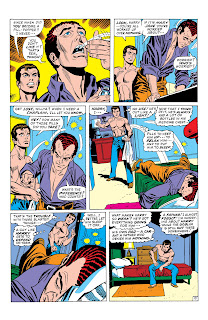Guest Star Spider-Man: Strange Tales Annual #2
I thought it would be interesting to see how Spider-Man was portrayed as a guest star in other comics during the first 100 issues of The Amazing Spider-Man.
Writer: Stan Lee
Penciler: Jack Kirby
Inker: Steve Ditko
Penciler: Jack Kirby
Inker: Steve Ditko
Looking at the cover, there's not a spider insignia on the front of Spider-Man's costume. Other than that, it's a solid cover. The story is just 18 pages. The rest of the 72 pages advertised on the cover is for reprints, monster stories before the Human Torch took over Strange Tales.
I haven't usually drawn attention to who the inker was, except it was Steve Ditko which helps bring Spider-Man closer in line to how he looked at the time.
So the story begins with the Human Torch jealous because Spider-Man has been getting favorable write ups in magazines and newspapers, which kind of contradicts how Spider-Man is portrayed in his own comic. Outside of Amazing Fantasy #15, Spider-Man seemed regularly vilified in the press, led by The Daily Bugle's J. Jonah Jameson. I started this blog to talk about MC2, of whom Spider-Girl is most famous character and she gets a mention here. Tom DeFalco would have a time travelling Spider-Girl battle the Human Torch in Spider-Girl #11.
A criminal, called the Fox, decides to steal a newly discovered Da Vinci and frame Spider-Man and a fickle press goes along with it.
I am delighted to find out that Sue and Johnny have a cat, even though we never see it. I like Spider-Man in the background outside the window while the Torch is on phone. Being the hothead he is, Johnny tries to attack the figure outside the window.
This is where, for a lack of a better word, the gags start happening and I don't mean that disparagingly. Kirby, early in his career, worked on Popeye cartoons and there would be a lot of gags to make the fights more interesting between Popeye and Bluto. The Torch and Spider-Man engage in one-upmanship with Spider-Man usually coming out the victor. The Torch tries to heat up the pool only for Spider-Man to hit him with a bulk of soaked webbing. The Torch tries to fool Spider-Man by creating flame doubles, but Spider-Man just runs around them. Finally, what seems to be the ultimate gag, Spider-Man rotates a cement mixer at high speed and covers the Torch.
In this comic, Spider-Man's running speed is used more here. His speed is usually used in tandem with his reflexes by most artists when dodging attacks. I think writers and artists tend to avoid showing Spider-Man running since he's a not a speedster like the Flash and it's much more prosaic than seeing him web swing around the city. In the aforementioned Amazing Spider-Man #267, Spider-Man chases a car on foot when web swinging was unavailable to him. I think it's kind of cool to see Spider-Man sprint at superhuman speed.
Spider-Man gets away from Johnny and gets to science lab to modify his webbing for their next encounter. Johnny, amusingly, thinks Spider-Man is spying on him with "Spider Vision." In Amazing Spider-Man #77, Spider-Man tricks the Human Torch by telling him he has "Spider-Sonic Hearing." Kirby makes an interesting choice here in that Spider-Man's mask is a cowl like Batman's and hangs on his costume which he pulls back over his face. Peter is mostly on model here and he's never referred to by his real name.
Spider-Man confronts the Torch again and Kirby does a good showing of Spider-Man's powers somersaulting away from the Torch, running up a building and running on a power line to lead the Torch in his trap, which is another clever gag in that the Torch lands in a web in which his flame causes vapors of ice and snow. The Torch frees himself by heating up his flame to a "cosmic blast" which sounds kind of dangerous to me. I remember when film critic Roger Ebert reviewed the 2005 Fantastic Four movie, he though the Human Torch had the ability to wipe out all life on this planet.
The Fox, disguised as an old lady, nearly gets the drop on Spider-Man. I guess if I had written it, I would have had a thought bubble from Spider-Man thinking about Aunt May when helping the "old lady."
We get more of Spider-Man's speed here. Although he's doing some jumping to compensate for the distance.
Spider-Man and the Human Torch would later team up against the Fox years later in Spider-Man: Unlimited #5, written by friends of the blog (in my own mind) Tom DeFalco and Ron Lim. While not featuring Spider-Man running at super speed, it does feature another underrated superpower of his: his heightened metabolism that protects him from the bad effects of fast food.


























Comments
Post a Comment